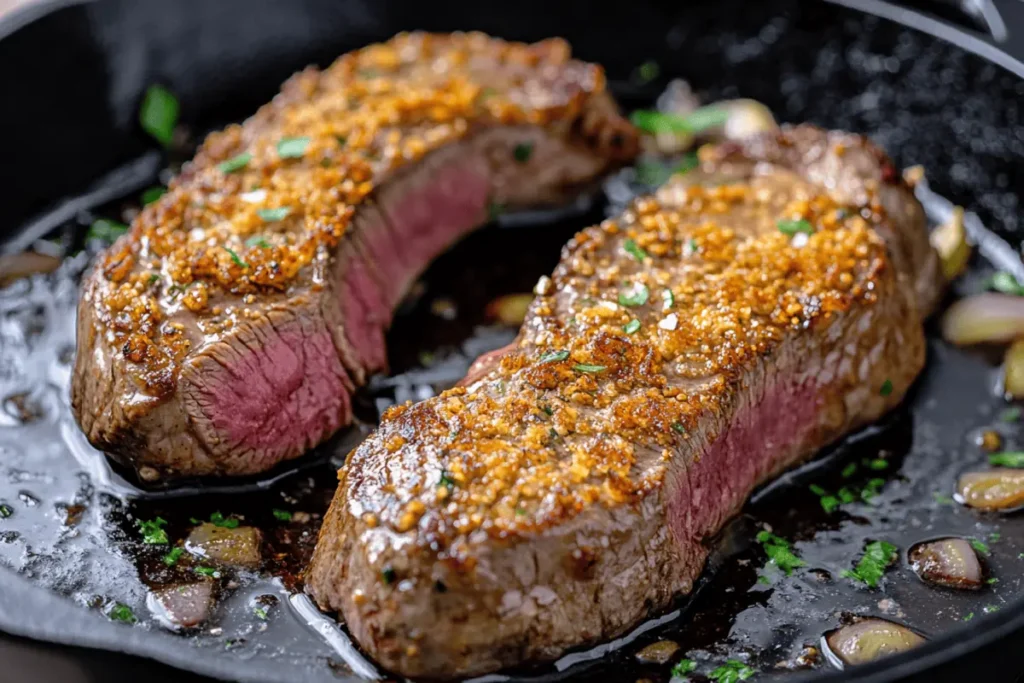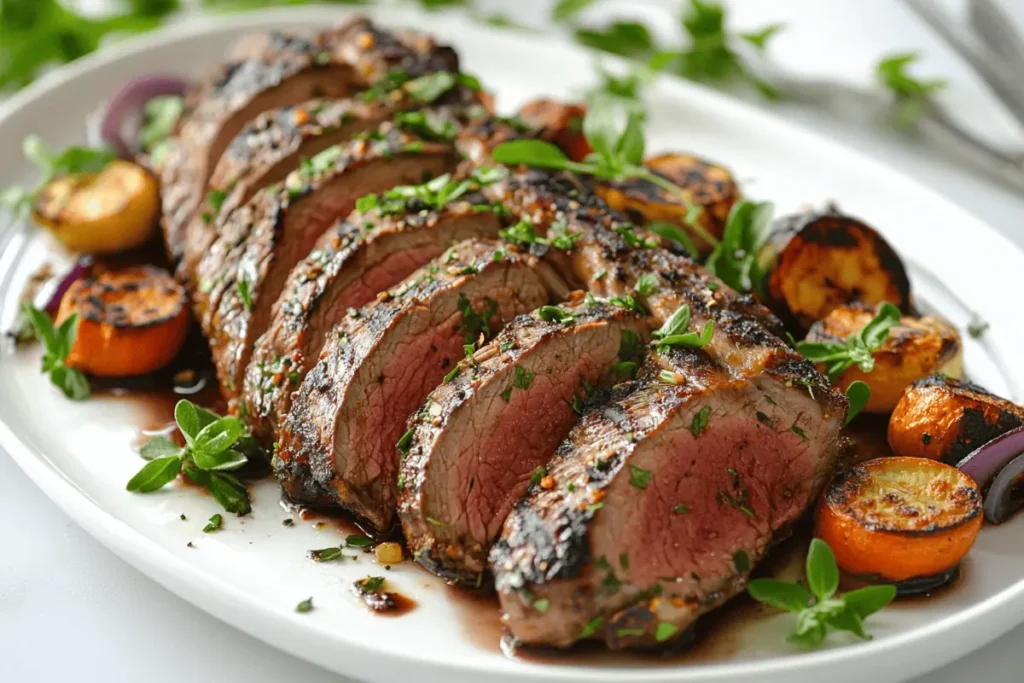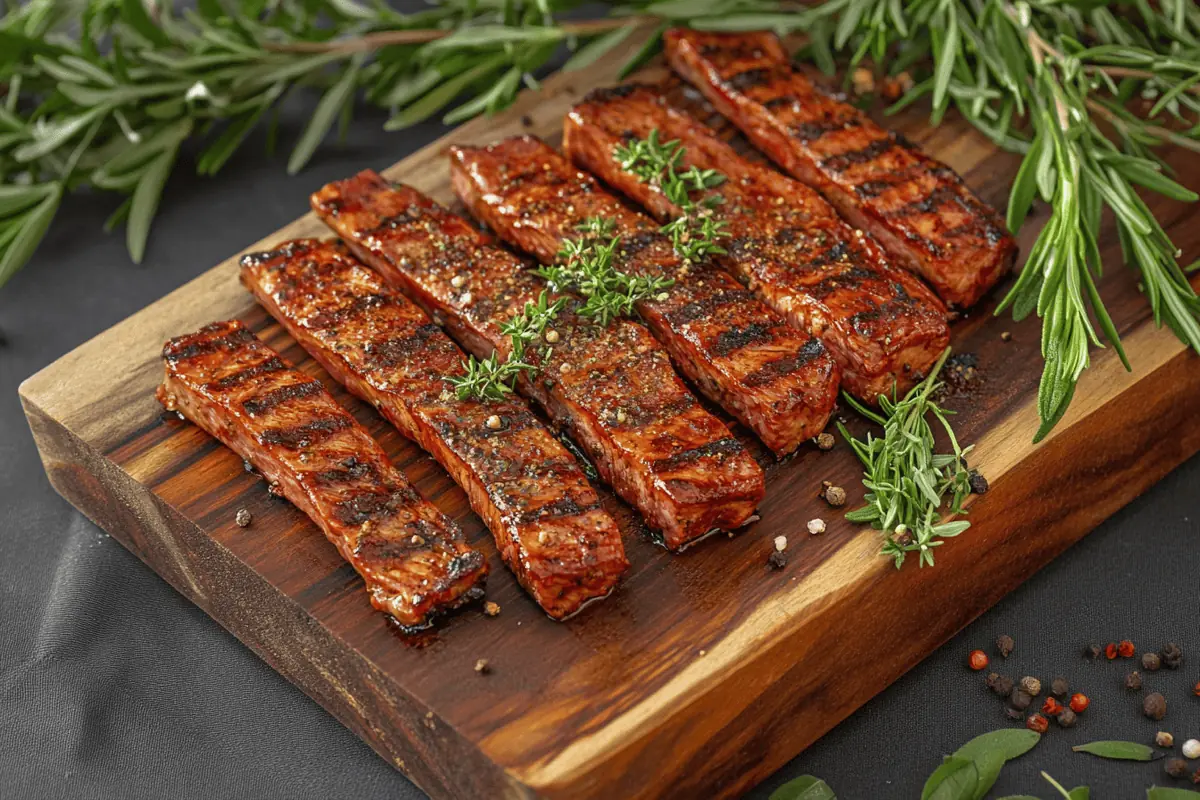Estimated reading time: 13 minutes
Cooking venison backstrap can elevate your culinary experience, enhancing both flavor and tenderness. If you’re wondering what do you soak a backstrap in, this comprehensive guide will provide you with all the information you need. From choosing the right soaking liquid to mastering cooking techniques, we’ve got you covered.
Table of contents
Understanding the Deer Backstrap
What is the Deer Backstrap?
The deer backstrap is a prized cut of venison located along the spine of the deer. Scientifically known as the longissimus dorsi, this muscle is lean, tender, and flavorful. Unlike other cuts, the backstrap has minimal fat, making it ideal for various cooking methods.
Why Soak Backstrap?
Soaking deer backstrap is a common practice aimed at enhancing its flavor and tenderness. The soaking process helps reduce any gamey taste and breaks down muscle fibers, resulting in a more tender bite. Additionally, soaking allows the meat to absorb marinades, infusing it with additional flavors. Whether you’re preparing for grilling, roasting, or pan-searing, soaking plays a vital role in the final outcome of your dish.
Soaking Methods for Backstrap
Marinades: The Classic Choice
Marinating is one of the most popular methods to soak a backstrap. A well-crafted marinade not only imparts flavor but also tenderizes the meat. Here’s how to create an effective marinade:
- Acidic Base: Use ingredients like vinegar, wine, or citrus juice to break down muscle fibers.
- Aromatics: Incorporate garlic, onions, and herbs such as rosemary or thyme for added flavor.
- Oils: Olive oil or vegetable oils help retain moisture during cooking.
For example, a red wine and rosemary marinade can complement the rich flavor of the backstrap beautifully. Marinate the meat for at least 2 hours, or overnight for maximum flavor penetration.
Sample Marinade Recipe
- 1 cup red wine
- 1/2 cup olive oil
- 4 cloves garlic, minced
- 2 tablespoons fresh rosemary, chopped
- 1 tablespoon balsamic vinegar
- Salt and pepper to taste
Combine all ingredients in a bowl, add the backstrap, and refrigerate for at least 2 hours.
Vinegar Soaking: Enhancing Tenderness
Many people wonder, why do people soak deer meat in vinegar. Vinegar is an excellent tenderizer due to its acidic nature. It breaks down tough muscle fibers, making the meat more tender. Here’s a simple vinegar soaking method:
- Prepare the Soak: Mix equal parts of red wine vinegar and water.
- Add Seasonings: Include garlic cloves, black peppercorns, and fresh herbs.
- Soak the Backstrap: Submerge the meat in the mixture and refrigerate for 4-6 hours.
This method not only tenderizes the meat but also imparts a subtle tangy flavor that enhances the overall taste of the dish.
Benefits of Vinegar Soaking
- Tenderizes Meat: The acidity breaks down muscle fibers.
- Reduces Gamey Flavor: Vinegar neutralizes strong gamey tastes.
- Infuses Flavor: Herbs and spices in the soak add depth to the meat.
Milk Soaking: A Creamy Approach
Another effective method is soaking the backstrap in milk. People often ask, why do you soak deer backstrap in milk. Milk contains enzymes and proteins that help break down the meat’s proteins, resulting in a more tender texture. Additionally, milk helps neutralize any gamey flavors, providing a milder taste. Here’s how to soak backstrap in milk:
- Choose the Right Milk: Whole milk is preferred for its higher fat content, which adds richness to the meat.
- Add Flavors: Enhance the soaking liquid with herbs like thyme or bay leaves and spices like black pepper.
- Soak the Meat: Place the backstrap in the milk mixture and refrigerate for 6-8 hours.
After soaking, pat the meat dry before cooking to ensure proper searing and browning.
Advantages of Milk Soaking
- Tenderizes Meat: Enzymes in milk break down proteins.
- Neutralizes Gamey Flavors: Milk softens strong tastes.
- Adds Richness: The fat in milk enhances the meat’s flavor.
Other Tenderizing Liquids
Apart from marinades, vinegar, and milk, there are other liquids you can use to soak backstrap:
- Beer: Adds a malty flavor and tenderizes the meat.
- Soy Sauce: Imparts a salty, umami flavor while tenderizing.
- Citrus Juices: Lemon or orange juice can brighten the flavors and tenderize the meat.
Each liquid offers a unique flavor profile, allowing you to customize the taste of your backstrap according to your preferences.
Beer Marinade Recipe
- 1 bottle of stout beer
- 1/4 cup soy sauce
- 2 tablespoons brown sugar
- 3 cloves garlic, minced
- 1 tablespoon Dijon mustard
Combine all ingredients, add the backstrap, and refrigerate for 4-6 hours.
Cooking After Soaking
Once you’ve soaked your backstrap, the next step is cooking it to perfection. Here are some popular cooking methods:
Grilling Backstrap
Grilling is a favored method for cooking backstrap due to its ability to impart a smoky flavor and create appealing grill marks. Follow these steps for perfectly grilled backstrap:
- Preheat the Grill: Ensure your grill is hot to achieve a good sear.
- Season the Meat: Even after soaking, a final seasoning with salt and pepper enhances flavor.
- Grill to Medium-Rare: Cook the backstrap for about 4-5 minutes per side, aiming for an internal temperature of 135°F.
- Rest the Meat: Let it rest for 10 minutes before slicing to retain juices.
Grilling allows the natural flavors of the backstrap to shine, making it a popular choice for outdoor cooking enthusiasts.
Tips for Grilling
- High Heat: Use high heat to sear the meat quickly.
- Avoid Flipping Frequently: Let the meat develop grill marks before flipping.
- Use a Meat Thermometer: Ensure precise cooking without overcooking.
Pan-Seared Backstrap Steaks
Pan-searing is another excellent method that offers precise control over the cooking process. Here’s how to achieve juicy, flavorful steaks:
- Heat the Pan: Use a heavy skillet, preferably cast-iron, and heat it over medium-high heat with a bit of oil.
- Sear the Steaks: Cook for 3-4 minutes on each side for medium-rare.
- Add Butter and Aromatics: During the last minute, add a pat of butter, garlic, and fresh herbs to baste the meat.
- Rest Before Serving: Allow the steaks to rest to ensure maximum tenderness.
Pan-searing is ideal for smaller backstrap cuts and provides a quick and flavorful cooking method.
Benefits of Pan-Searing
- Control Over Cooking: Precise temperature management.
- Flavorful Crust: Develops a delicious sear on the outside.
- Quick Method: Ideal for weeknight dinners.

Roasting Backstrap in the Oven
Roasting is perfect for larger backstrap cuts, ensuring even cooking and a succulent result. Follow these steps for perfectly roasted backstrap:
- Preheat the Oven: Set to 400°F for a hot cooking environment that promotes browning.
- Season Generously: Use a rub with spices like thyme, garlic, and paprika.
- Sear First: Sear the backstrap in a hot skillet to develop a crust before roasting.
- Roast to Medium-Rare: Cook until the internal temperature reaches 135°F.
- Rest the Meat: Let it rest before slicing to maintain moisture and tenderness.
Roasting allows for large cuts to be cooked evenly, making it ideal for family gatherings and special occasions.

Roasting Tips
- Use a Meat Thermometer: Ensure accurate doneness.
- Baste During Roasting: Occasionally baste with pan juices for added flavor.
- Proper Ventilation: Let excess fat drip away to prevent flare-ups.
Advanced Cooking Techniques
Sous Vide Cooking
Sous vide is a modern cooking method that involves vacuum-sealing the backstrap and cooking it in a temperature-controlled water bath. This technique ensures precise cooking and enhances tenderness.
- Season the Meat: Season with salt, pepper, and herbs.
- Vacuum Seal: Place the backstrap in a vacuum-sealed bag.
- Set the Temperature: Cook at 130°F for medium-rare for 2-4 hours.
- Sear After Cooking: Quickly sear the meat in a hot pan to develop a crust.
Sous vide cooking provides consistent results and allows for greater control over the final texture of the venison.
Benefits of Sous Vide
- Precision Cooking: Exact temperature control prevents overcooking.
- Enhanced Tenderness: Slow cooking breaks down muscle fibers.
- Flavor Infusion: Vacuum-sealing allows flavors to penetrate deeply.
Smoking the Backstrap
Smoking infuses the backstrap with a deep, smoky flavor, enhancing its natural taste.
- Prepare the Smoker: Preheat to 225°F and add your preferred wood chips, such as hickory or applewood.
- Season the Meat: Apply a dry rub with spices like paprika, garlic powder, and black pepper.
- Smoke Slowly: Cook until the internal temperature reaches 135°F for medium-rare.
- Rest Before Slicing: Let the meat rest to retain its juices.
Tips
- Choose the Right Wood: Different woods impart different flavors.
- Maintain Temperature: Keep a consistent temperature for even cooking.
- Monitor Moisture: Avoid drying out the meat by maintaining adequate moisture in the smoker.
Braising for Extra Tenderness
Braising involves cooking the backstrap slowly in liquid, resulting in exceptionally tender meat.
- Sear the Meat: Brown the backstrap in a hot pan to develop flavor.
- Prepare the Braising Liquid: Use a mixture of broth, wine, vegetables, and herbs.
- Slow Cook: Cover the meat and cook in the oven at 325°F for 2-3 hours until tender.
- Reduce the Sauce: After cooking, reduce the braising liquid to create a flavorful sauce.
Advantages of Braising
- Enhanced Flavor: Cooking in liquid infuses the meat with rich flavors.
- Tender Texture: Slow cooking breaks down tough fibers.
- Versatility: Braising liquids can be customized to your taste preferences.
Choosing venison as part of a balanced diet can enhance your nutritional intake and support overall well-being.
Enhancing Flavor with Marinades and Rubs
Creating the Perfect Marinade
A well-crafted marinade can significantly enhance the flavor and tenderness of the backstrap. Consider the following components:
- Acidic Base: Vinegar, wine, or citrus juice to tenderize the meat.
- Aromatics: Garlic, onions, and herbs like rosemary or thyme for added flavor.
- Oils: Olive oil or other vegetable oils to retain moisture.
For example, a red wine and rosemary marinade can complement the rich flavor of the backstrap beautifully. Combine these ingredients in a bowl, add the backstrap, and let it marinate for at least 2 hours or overnight in the refrigerator.
Tips for Effective Marinades
- Balance Flavors: Ensure a good balance of acidity, sweetness, and savory elements.
- Use Fresh Ingredients: Fresh herbs and spices provide the best flavor.
- Don’t Overdo It: Avoid overpowering the natural flavor of the meat.
Crafting a Dry Rub
Dry rubs are another excellent way to infuse flavor into the backstrap without adding moisture. A typical dry rub includes:
- Spices: Paprika, black pepper, and cayenne for heat.
- Herbs: Dried oregano or thyme for aromatic depth.
- Sweeteners: Brown sugar or honey for a touch of sweetness.
Apply the dry rub generously to the backstrap and allow it to rest for at least an hour before cooking to let the flavors penetrate the meat.
Benefits of Dry Rubs
- Flavor Concentration: Spices adhere to the meat, creating a flavorful crust.
- Texture Enhancement: Dry rubs can create a desirable texture on the exterior.
- Versatility: Easy to customize based on personal preferences.
Common Mistakes to Avoid
Overcooking the Meat
Venison is lean and can become tough if overcooked. Always monitor the internal temperature to ensure it remains tender and juicy. Aim for medium-rare to medium doneness.
How to Prevent Overcooking
- Use a Meat Thermometer: Ensures accurate cooking.
- Monitor Cooking Time: Keep track of cooking durations.
- Remove Early: Take the meat off the heat slightly before reaching the desired temperature.
Not Letting the Meat Rest
Skipping the resting period can result in dry meat. Allowing the backstrap to rest helps retain juices and improves texture. Cover the meat loosely with foil and let it sit for about 10 minutes before slicing.
Importance of Resting
- Juice Redistribution: Ensures even moisture distribution.
- Flavor Enhancement: Juices settle, enhancing flavor.
- Texture Improvement: Results in a more tender bite.
Using the Wrong Cut
Using other cuts instead of the backstrap can lead to a less tender and flavorful dish. Stick to the backstrap for the best results.
Best Cuts for Soaking and Cooking
- Backstrap (Longissimus Dorsi): Most tender and flavorful.
- Ribeye: Offers more fat and marbling.
- Tenderloin: Extremely tender but lean.
Ignoring Marinade Times
Marinating the meat for too short or too long can affect flavor and texture. Follow recommended marinating times to achieve the desired outcome.
How to Optimize Marinade Times
- Short Marinades: 2-4 hours for less tenderizing and lighter flavor.
- Long Marinades: 6-24 hours for deeper flavor and greater tenderness.
- Avoid Over-Marinating: Prevent mushy texture by not exceeding recommended times.
Sustainability and Ethical Considerations
Sustainable Hunting Practices
Choosing venison from sustainable and ethical sources ensures the preservation of deer populations and the environment. Look for suppliers that adhere to sustainable hunting practices and promote wildlife conservation. Sustainable hunting helps maintain ecological balance and supports responsible meat consumption.
How to Identify Sustainable Practices
- Licensing and Permits: Ensure hunters have proper licenses.
- Population Management: Support practices that prevent overhunting.
- Habitat Conservation: Choose suppliers committed to preserving natural habitats.
Responsible Meat Consumption
Consuming venison responsibly involves understanding the source of your meat and supporting ethical practices. This not only benefits the environment but also ensures the quality and safety of the meat you consume. Always purchase venison from reputable suppliers who prioritize humane hunting and processing methods.
Benefits of Responsible Consumption
- Environmental Impact: Reduces ecological footprint.
- Animal Welfare: Ensures ethical treatment of animals.
- Quality Assurance: Guarantees safe and high-quality meat.
Supporting Local Hunters
Purchasing venison from local hunters can support community economies and reduce the carbon footprint associated with transporting meat over long distances. It also allows you to know the exact origin and handling of your meat, ensuring freshness and quality.
Advantages of Local Sourcing
- Freshness: Fresher meat compared to long-distance transportation.
- Community Support: Helps sustain local economies.
- Traceability: Better understanding of meat origin and handling.
Frequently Asked Questions
What do you soak a backstrap in?
You can soak a backstrap in various liquids to enhance its flavor and tenderness. Common soaking liquids include:
- Marinades: Mixtures of acidic bases, aromatics, and oils.
- Vinegar Solutions: A blend of vinegar and water with added herbs and spices.
- Milk: Whole milk with added herbs and spices for a creamy soak.
- Beer or Wine: Adds unique flavors and tenderizes the meat.
Choosing the right soaking liquid depends on your flavor preferences and desired tenderness.
Why do people soak deer meat in vinegar?
People soak deer meat in vinegar because its acidic properties help tenderize the meat by breaking down tough muscle fibers. Vinegar also helps to reduce gamey flavors, making the meat more palatable. Additionally, vinegar-based marinades can infuse the meat with rich flavors from added herbs and spices.
Why do you soak deer backstrap in milk?
Soaking deer backstrap in milk is a popular method for tenderizing the meat and neutralizing gamey flavors. Milk contains enzymes and proteins that help break down the meat’s proteins, resulting in a more tender texture. The creamy soak also adds a subtle richness to the meat, enhancing its natural flavors.
What liquid should I tenderize deer meat with?
There are several liquids you can use to tenderize deer meat, including:
- Vinegar: Effective for breaking down muscle fibers.
- Wine: Adds depth of flavor while tenderizing.
- Beer: Imparts a malty flavor and tenderizes the meat.
- Citrus Juices: Lemon or orange juice can brighten flavors and tenderize.
- Milk: Creamy soak that tenderizes and neutralizes gamey flavors.
Choose a liquid based on your desired flavor profile and the level of tenderness you want to achieve.
Conclusion
Understanding what do you soak a backstrap in is essential for preparing a delicious and tender deer backstrap dish. Whether you choose marinades, vinegar solutions, milk, or other tenderizing liquids, soaking plays a crucial role in enhancing the meat’s flavor and texture. Remember to select high-quality meat, adhere to proper soaking times, and choose the right cooking method to achieve the best results. By following these guidelines, you can create a memorable venison meal that showcases the rich flavors and tenderness of the backstrap. Enjoy your culinary adventure with soaked backstrap, and savor the delightful taste of venison.

